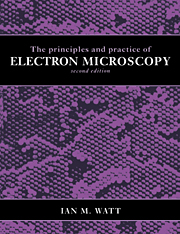Book contents
- Frontmatter
- Contents
- Preface to first edition
- Preface to second edition
- 1 Microscopy with light and electrons
- 2 Electron–specimen interactions: processes and detectors
- 3 The electron microscope family
- 4 Specimen preparation for electron microscopy
- 5 The interpretation and analysis of micrographs, pages 189 to 223
- The interpretation and analysis of micrographs, pages 224 to 262
- 6 Analysis in the electron microscope
- 7 Specialised EM- and other microscopical and analytical techniques
- 8 Examples of the use of electron microscopy
- Appendixes
- Bibliography
- Name index
- Subject index
Preface to second edition
Published online by Cambridge University Press: 05 June 2012
- Frontmatter
- Contents
- Preface to first edition
- Preface to second edition
- 1 Microscopy with light and electrons
- 2 Electron–specimen interactions: processes and detectors
- 3 The electron microscope family
- 4 Specimen preparation for electron microscopy
- 5 The interpretation and analysis of micrographs, pages 189 to 223
- The interpretation and analysis of micrographs, pages 224 to 262
- 6 Analysis in the electron microscope
- 7 Specialised EM- and other microscopical and analytical techniques
- 8 Examples of the use of electron microscopy
- Appendixes
- Bibliography
- Name index
- Subject index
Summary
Since publication of the previous edition the pace of computerisation and automation has been relentless, and in much current equipment the mouse reigns supreme! But at the same time as making the new edition necessary to encompass the new technologies, the potential readership has been broadened to include those new users who could be helped with some of the background to their ‘point and shoot’ microscopes.
Since electron microscopes seldom wear out, and tight economic conditions worldwide have led users to delay replacing their instrument until design changes have slowed down, the book has to be updated by adding information: little of the old technology is not still used by someone, somewhere (one only has to survey the current literature to see how much work is still being reported using JSM 35s and EM 301s, for example). The newer instruments work using the same principles as they did twenty years ago, but the electron optics and the results are better understood than they were. Hence we have new chapters on processes occurring between beam and specimen, and the analytical capabilities of electron microscopes. The digital imaging revolution is described, and the developments in dealing with moist specimens, from cryo-preparation to environmental microscopy.
Since the first edition the writer has retired from practical electron microscopy, but has been encouraged to keep abreast of the latest developments in microscopy as a whole as Technical Editor of Microscopy and Analysis magazine.
- Type
- Chapter
- Information
- The Principles and Practice of Electron Microscopy , pp. xi - xiiPublisher: Cambridge University PressPrint publication year: 1997

